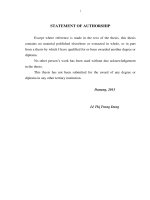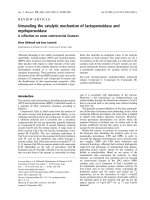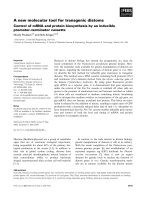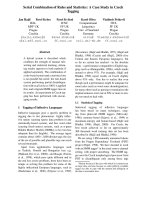Phytoremediation of nitrate and bisphenol a by scindapsus auresus
Bạn đang xem bản rút gọn của tài liệu. Xem và tải ngay bản đầy đủ của tài liệu tại đây (3.9 MB, 208 trang )
Chapter 1. Introduction
Phytoremediation is a technology that utilizes plants and associated
rhizopheric microorganisms to remove pollutants and ‘clean’ contaminated soils and
water (Dietz and Schnoor, 2001; Singh et al., 2003). This technology has gained the
interest of government agencies and industries in recent years (Pilon-Smits, 2005),
due to a number of reasons. With plants playing the major role, most of their
processes are sun-dependent, making phytoremediation very much cheaper than the
various engineering methods used at present to treat contaminated areas (Salt et al.,
1998; Pilon-Smits, 2005). Also, phytoremediation can be carried out at the site of
contamination, thus reducing exposure of humans and wildlife to toxins and
contaminants (Pilon-Smits, 2005). Lastly, the use of plants helps to project an
environmentally-friendly image as opposed to chemical plants (Pilon-Smits, 2005)
and, depending on the species used, the plants may also be aesthetically pleasing
(Dietz and Schnoor, 2001), hence gaining popularity with the general public. Due to
the many advantages of phytoremediation, ongoing research is taking place to better
develop this technology. These studies not only focus on finding plant species capable
of phytoremediating the contaminated sites, but also on identifying the exact
mechanisms, genes, enzymes and physiological processes involved.
Nitrate (NO3-) pollution of surface water has been a major problem in several
countries. NO3- is one of the two forms of inorganic N introduced excessively into the
environment via anthropogenic sources such as agricultural run-offs and point-source
discharges of sewage effluents and industrial wastewater (Camargo and Alonso, 2006;
Maier et al., 2009; O’Shea and Wade, 2009). High levels of NO3- pollution of surface
water are hazardous to the environment, causing eutrophication of freshwater and
1
marine ecosystems (Camargo and Alonso, 2006; Maier et al., 2009), and
contamination of groundwater (Rivett et al., 2008; Umezawa et al., 2008). NO3- at
high concentrations can easily be converted into nitrite (NO2-), causing health
problems such as methaemoglobinaemia and gastro-intestinal cancers (Camargo and
Alonso, 2006; Hsu et al., 2009). Therefore, there is a pressing need to come up with
new methods and technologies to remove and/or control NO3- levels in surface water.
Another pollutant that is a major problem in several developed countries is the
organic chemical, bisphenol A (BPA). BPA (CAS Registry No. 80-05-7), also known
as 4,4’-isopropylidenediphenol, is commonly used in the production of polycarbonate
plastic and as a plasticizer (Staples et al., 1998; Sajiki and Yonekubo, 2003). The
exposure of BPA-containing plastic to heat, acidic or alkaline conditions as well as
the duration of the exposure to these conditions can lead to the release of BPA into the
environment, risking contact of humans and wildlife to it (López-Cervantes et al.,
2003; Kang et al., 2006a; Richter et al., 2007). High BPA levels have been detected in
wastewater from sewage treatment plants and manufacturing factories, as well as
leachates from water landfills (Staples et al., 1998; Yamamoto et al., 2001; Fromme et
al., 2002; Kang and Kondo, 2006). These effluents result in BPA contamination of the
aquatic environment. Several studies have shown that aquatic organisms can absorb
and accumulate BPA (Staples et al., 1998; Heinonen et al., 2002; Li et al., 2009b).
The bioaccumulated BPA can then make its way up the food chain (Muñoz et al.,
1996; Li et al., 2009b) and into humans via aquatic food sources (Basheer et al., 2004).
BPA has been shown to act as an endocrine disrupting chemical by mimicking the
effects of estrogen (Kang et al., 2006a; Richter et al., 2007). Studies have shown that
exposure of mice to BPA can lead to advanced puberty (Howdeshell et al., 1999;
2
Ryan and Vandenbergh, 2006), increased aggression and anxiety (Kawai et al., 2003;
Ryan and Vandenbergh, 2006), as well as upregulated expression of several hormone
receptors (Ramos et al., 2003). Therefore, there is also an urgent need to remove
and/or degrade BPA from the environment, in order to decrease the potential harm of
BPA to the aquatic ecosystems and even to humans.
Although, at present, there are several existing engineering and chemical
methods available to remove NO3- and BPA from water bodies, these methods
involve the construction of elaborate infrastructures, usage of excessive chemicals and
transportation of the polluted waters away from the source, resulting in high monetary
costs and the risk of public exposure to the polluted waters (Pilon Smits, 2005). As
compared to these existing methods, phytoremediation is much more desirable
because the use of plants allows for on-site bioremediation of the contaminated waters
without incurring high costs (Pilon Smits, 2005).
This project focused on the use of Scindapsus aureus (Lindl. & André) Engl.
(Golden Pothos) in the phytoremediation of NO3- and BPA contaminated waters.
Characteristics of S. aureus that make it a potential study candidate for
phytoremediation of water bodies include its tolerance to submergence of roots in
water, high growth rate under submerged conditions and easy propagation via shoot
cuttings. The ability of S. aureus to grow in water allows for phytoremediation in situ.
High growth rate and easy propagation are both indicators of efficient
phytoremediating plant species (Brix and Schierup, 1989; Forni et al., 2001).
Furthermore, S. aureus is sold in the market as an ornamental house-plant, indicating
that it has both aesthetic and commercial values. Hence, the use of S. aureus in
phytoremediation may bring along additional aesthetic and commercial values.
3
Aside from determining the phytoremediation potential of S. aureus, it is also
necessary to study the physiological impact of high NO3- and BPA levels on the plant
to ensure that this species can be used for long-term phytoremediation of these
pollutants without causing detrimental effects to the ecosystem or the plant itself.
Therefore, the objectives of this study included the determination of the
phytoremediation efficiency of S. aureus in removing NO3- and BPA from water as
well as the physiological responses of S. aureus to high NO3- and BPA levels, in
terms of plant growth and metabolism, photosynthetic capacity, oxidative stress levels
and the activities of antioxidant enzymes, including ascorbate peroxidase, glutathione
reductase, superoxide dismutase and guaiacol peroxidase.
4
Chapter 2. Literature Review
2.1 Phytoremediation
Phytoremediation refers to the use of plants and their associated microbes for
the cleanup of environmental pollution (Pilon-Smits, 2005). This technology has been
under extensive research in recent years due to a number of benefits that it brings. As
mentioned in the introduction chapter, phytoremediation has captured the attention of
several government agencies and industries because if carried out on a full scale, it
can be more cost-effective and is potentially safer than existing physical and chemical
methods (Salt et al., 1998; Pilon-Smits, 2005). Arthur et al. (2005) reported that
current price estimates for remediation of full-scale commercial sites could begin at
US$ 200,000, with an additional US$40 – 70 per cubic yard of soil. In contrast, the
use of plants is solar-dependant, which makes the process of decontamination much
cheaper. Also, the use of plants is environmentally-friendly and aesthetically pleasing,
which makes phytoremediation a publically acceptable way to remove environmental
pollutants (Arthur et al., 2005; Pilon-Smits, 2005).
Phytoremediation can be used to treat soils and sediments, water bodies and
even the surrounding atmosphere (Pilon-Smits, 2005). A large number of inorganic
pollutants, such as plant macronutrients (nitrates and phosphates, for instance), heavy
metals and radioactive isotopes, as well as organic pollutants, such as polyaromatic
hydrocarbons (PAH), explosives (TNT), petrochemicals, polychlorinated biphenyls
(PCBs) and bisphenol A (BPA) can be phytoremediated (Arthur et al., 2005; PilonSmits, 2005). Also, through research, a large number of botanical families with
phytoremediating capabilities have been identified (Gawronski and Gawronska, 2007)
and several databases such as PHYTOPET and PHYTOREM have compiled lists of
5
plants that can specifically remediate petroleum hydrocarbons and heavy metals,
respectively (Pilon-Smits, 2005).
Plants can treat pollutants in a number of ways (Fig. 1). First, pollutants can be
extracted by the plants and accumulated in the tissues, after which the plants can be
removed together with the pollutants – a process termed phytoextraction (Arthur et al.,
2005; Pilon-Smits, 2005). For example, Murakami and Ae (2009) reported the ability
of Oryza sativa (rice) and Zea mays (corn) to phytoextract copper, and the ability of
Glycine max (soybean) to phytoextract zinc. Second, plants can also take up the
contaminants and degrade them into harmless compounds via enzymatic activities
within their tissues, a process known as phytodegradation (Arthur et al., 2005; PilonSmits, 2005). Reed wetlands have been reported to be able to phytodegrade extra
heavy oil hydrocarbons without much impact on the long-term reed yield of the
wetlands (Ji et al., 2004). Third, contaminants absorbed into plant tissues can be
converted to volatile forms and eventually leave the plant through a process called
phytovolatilization (Arthur et al., 2005; Pilon-Smits, 2005). Pilon-Smits et al. (1998)
reported the volatilization and assimilation of selenium by Populus tremula x alba).
Fourth, the roots of certain plant species can convert contaminants to less bioavailable
forms in order to prevent leaching or runoff in a process termed phytostabilization
(Arthur et al., 2005; Pilon-Smits, 2005). For instance, Quercus ilex (Holm oak) was
not only tolerant to high levels of cadmium, but the fine roots of the plants were also
able to retain the metal within the soil without translocation into the leaves
(Domínguez et al., 2009). Lastly, plants can also stimulate microbial growth and
activity at the rhizospheric region to induce degradation of contaminants by these
microbes. This process is termed as phytostimulation (Arthur et al., 2005; Pilon-Smits,
6
Fig. 1. Potential fates of pollutants (black circles) during phytoremediation. Pollutants
can be stabilized or degraded in the rhizosphere, accumulated or degraded within
plant tissues, or volatilized. (Figure modified from Pilon-Smits, 2005).
7
2005). Toyama et al., (2006) reported that degradation of organic chemicals (phenol,
aniline and 2,4-dichlorophenol) by Spirodela polyrrhiza (giant duckweed) was
accelerated by the selective accumulation of certain bacterial strains in its rhizosphere.
Similarly for Phragmites australis, the degradation of bisphenols was accelerated by
the interactions between the plants and bisphenol degrading bacteria,
Novosphingobium sp. strain TYA-a and Sphingobium yanoikuyae strain TYF-1
Toyama et al., (2009).
Studies on phytoremediation are mainly targeted at the potential of different
plants to remove the target pollutant from the substrate and on the practicality of
applying this technology out in the field (Dushenkov et al., 1995; Newman et al.,
1999; Huang et al., 2000; Sooknah and Wilkie, 2004; Novak and Chan., 2008). Yet,
the ability to fully utilize the potential of plants for phytoremediation is restricted by
limited understanding of plant metabolism and tolerance mechanisms (Doran, 2009).
Therefore, in recent years, more research is extended towards comprehending the
biological pathways behind phytoremediation potentials of the plants (Schrӧder and
Collins, 2002; Singer et al., 2003; Singh et al., 2003). The increased use of plant
tissue culture techniques in the study of phytoremediation has assisted in the
understanding of the responses and metabolic pathways of plants towards various
pollutants up to the cellular level. Plant tissue culture involves the growth of plant
cells and tissues in vitro under aseptic conditions and because cells and tissues are
grown under a microbe-free environment, the physiological responses and metabolic
capabilities of plant cells can be clearly distinguished from those of microorganisms
commonly present in plant tissues or rhizospheric regons (Doran, 2009). The form of
tissue culture most commonly utilized in phytoremediation studies are cell
8
suspensions and hairy roots (Doran, 2009), but whole plants have also been employed
(Imai et al., 2007).
Aside from physiological and metabolic studies, a lot of focus has also been
placed on molecular responses towards plant uptake of pollutants. Plant molecular
ecotoxicology investigates the ecological implications of genetic and molecular
responses to contaminants and helps in the understanding of relationships between
plant genotypes and ecological phenotypes, the regulatory networks formed by
secondary messenger, as well as transcriptional and post-transcriptional events
induced by exposure to certain pollutants (Sandermann Jr., 2004). Also, several
transgenic plants with enhanced abilities to degrade xenobiotics (Eapen et al., 2007)
and sequester or detoxify heavy metals (Yang et al., 2005) have been developed using
genetic engineering.
2.2 Phytoremediation of Nitrates
2.2.1 Nitrate Pollution
Nitrate (NO3-) is one of the main forms of inorganic nitrogen (N) introduced
excessively into the environment via anthropogenic sources. It has been reported that
current human activities have severely altered the global nitrogen cycle, and the rate
of N input is still increasing (Camargo and Alonso, 2006). The most widely known
cause of NO3- pollution is agricultural run-offs, of which farmers use large amounts of
NO3- fertilizers to boost their crop growth and the excess NO3- leach into the
surrounding water bodies, contaminating them (Kurosawa et al., 2004; Camargo and
Alonso, 2006; Cherry et al., 2008; Maier et al., 2009; O’Shea and Wade, 2009). In
9
urban regions, NO3- pollution of surface waters is also prevalent. Point source
discharges of sewage effluents and industrial wastewater contribute to high NO3levels detected in the waterways of urbanized cities (Forni et al., 2001; Camargo and
Alonso, 2006; Li et al., 2007; Maier et al., 2009; O’Shea and Wade, 2009).
The risks that NO3- pollutant cause to human health and the environment have
resulted in an array of legislations set by governments and organizations all over the
world to control NO3- levels in surface water bodies (O’Shea and Wade, 2009). In the
UK, the Drinking Water Directive set a maximum limit of 11.3 mg-N/L in drinking
water (O’Shea and Wade, 2009). The World Health Organization and Europeon
Union also set a rule to maintain water NO3- levels below 50 mg/L, with a limit cap at
100 mg/L (World Health Organization, 2006; Umezawa et al., 2008). In Japan and the
United States, federal standards are set at 10 mg-N/L (Umezawa et al., 2008). In
Singapore, the Public Utilities Board (PUB) has also set a regulatory guideline to
maintain NO3- levels in drinking water to be below 45 mg/L (World Health
Organization, 2006).
High levels of NO3- pollution of surface water bring adverse effects to the
environment. Eutrophication of water bodies is the result of the release of surplus
NO3- into surface waters. Highly eutrophic waters lead to undesirable algal blooms,
which may contain toxic species. Eutrophication can drastically affect the structure
and function of freshwater, marine and terrestrial ecosystems through poisoning, loss
of keystone aquatic species, or even the loss of light and oxygen supply in water
(Camargo and Alonso, 2006; Maier et al., 2009; O’Shea and Wade, 2009). NO3- from
surface waters can even enter groundwater, degrading the quality of human drinking
water (Rivett et al., 2008; Umezawa et al., 2008). Furthermore, NO3- at high
10
concentrations can easily be converted into nitrite (NO2-). The ingestion of NO2--rich
water can cause methaemoglobinaemia or ‘blue-blood syndrome’ in infants (Camargo
and Alonso, 2006). This condition can be fatal if not detected early and treated.
Ingested NO2- may be converted into N-nitroso compounds, which are potent
carcinogens suspected to cause gastro-intestinal cancers (Camargo and Alonso, 2006;
Hsu et al., 2009).
2.2.2 Methods for Phytoremediation of Nitrate from Water
Due to the hazardous effects that NO3- can bring, several technologies have
been developed in order to remove it from drinking water and various water bodies.
These techniques include the use of activated carbon to remove NO3- (Demiral and
Gündüzoğlu, 2010), reverse osmosis (Schoeman and Steyn, 2003), ion exchange
(Samatya et al., 2006), electrodialysis and chemical adsorption (Menkouchi Sahli et
al., 2008) and even microbial treatment (Ayyasamy et al., 2007). These methods may
be effective in the removal of NO3-, but they are expensive to set up on a big scale.
(Kapoor and Viraraghavan, 1997; Ayyasamy et al., 2009). Also, microbial treatments
require external supplies of organic carbon and nutrients, which may not be fully
consumed and can become secondary pollutants, hence requiring extensive post
treatments to remove (Ayyasamy et al., 2009).
Taking all these limitations into consideration, phytoremediation appears as a
more preferred alternative method for NO3- removal. There are several different
approaches for the phytoremediation of NO3-. One approach is the use of floating beds
made up of aquatic macrophytes for NO3- phytoremediation. Several floating aquatic
plant species such as Azolla filiculoides (Forni et al., 2001), Eichhornia crassipes,
Pistia stratiotes (Sooknah and Wilkie, 2004; Ayyasamy et al., 2009), Hydrocotyle
11
umbellate (Sooknah and Wilkie, 2004), Salvinia molesta (Ayyasamy et al., 2009),
Salvinia minima and Spirodela polyrrhiza (Olguín and Sánchez-Galván, 2007) have
been assessed for their abilities to remove NO3- from organic wastewater and
groundwater. These plants were able to phytoremediate NO3- from concentrations up
to 500 mg/L, although the efficiency of NO3- removal decreased during exposure to
500 mg/L NO3- concentrations (Ayyasamy et al., 2009). However, several of the
aquatic plants studied (e.g. Eichhornia crassipes) are considered weeds in freshwater
bodies and have been known to rapidly colonize freshwater bodies, resulting in the
collapse of aquatic eco-populations (Li et al., 2007). The large-scale use of these
plants for NO3- phytoremediation may not be beneficial in the long term.
The use of the root systems of terrestrial plants to create a rhizofitration
system of floating beds for the removal of NO3- from water has also been studied.
Monnet et al. (2002) has reported the use of horticultural roses to treat domestic
wastewater and observed that the system was efficient in the removal of inorganic N
and phosphate (P). Li et al. (2007; 2009) also used Ipomoea aquatica to remove NO3from eutrophic water and even utilized low energy N+ ion implantation as a mutagen
to increase the growth and nitrogen-removal efficiency of these plants. However,
these methods require high cost to set up in a big scale as extensive infrastructure and
equipment are required.
Another approach is the use of constructed wetlands, made up of emergent
plants such as Phragmites australis (Huett et al., 2005), Scirpus cyperinus and Typha
latifolia (Huang et al., 2000). The roots of these emergent plants were found to be
efficient absorbers of NO3- (Huang et al., 2000; Huett et al., 2005). In China,
phytoremediation projects involving constructed wetlands have already been
12
established and one such project in the Hangzhou Botanical Garden has indeed greatly
improved the quality of the groundwater resource (Yang et al., 2008).
Despite the effectiveness of the various phytoremediation methods developed
for the removal of NO3-, they still have their limitations with respect to fieldapplications. The efficiency of NO3- removal is highly dependent upon genetic and
environmental factors and these are attributed to the choice of plant species and the
way in which they are utilized (Li et al., 2007). Therefore, further studies to identify
new plant species and improve on the setup are required to elevate the efficiency of
NO3- removal and promote field-applications.
2.2.3 Nitrate Absorption and Assimilation
In order to study the phytoremediation mechanisms of plants, it is essential to
first understand how plants absorb and assimilate NO3-. As NO3- is considered a ratelimiting nutrient for plant growth (Redinbaugh and Campbell, 1991; Leleu et al.,
2000), the concentration of NO3- available to plants can lead to several physiological,
biochemical and even molecular changes in the plants. Deficiencies in NO3--N can
lead to decrease in leaf growth (Lawlor et al., 2001), increase in root: shoot biomass
ratio (Ingestad and Ågren, 1991; Améziane et al., 1997; Touraine et al., 2001;
Hermans et al., 2006), decreased photosynthetic capacity (Khamis et al., 1990;
Skillman and Osmond, 1998) and accumulation of carbohydrates in leaves (Scheible
et al., 1997; Hermans et al., 2006).
NO3- Metabolism
NO3- influx into roots is an active process, driven by the H+ gradient (Forde,
2002), which explains the alkalization of the surrounding medium in which the plant
13
grows in (Tischner and Kaiser, 2007). NO3- uptake involved two or more H+ cotransported with every NO3- (Crawford, 1995). Kinetic experiments on net NO3uptake have provided evidence of two distinct transport components to the NO3uptake mechanism, namely the high-affinity transport systems (HATS) and lowaffinity transport systems (LATS) (Grignon et al., 2001; Touraine et al., 2001). Both
LATS and HATS are strongly dependent on the NO3- concentration available and the
plant internal N demand. HATS are capable of efficiently transporting NO3- even
when its concentration in the medium is extremely low, in the range of just 10 µM
(Grignon et al., 2001). There are two different HATS systems – a low capacity
constitutive high-affinity transport system (cHATS) and a high capacity inducible
high-affinity transport system (iHATS) (Touraine et al., 2001). cHATS plays an
important role in allowing the cytoplasmic concentrations of NO3- to rise to levels
enough to induce iHATS (Touraine et al., 2001). iHATS is a multicomponent system,
partly encoded by genes of the NRT2 family (Forde, 2000). In the absence of NO3-,
NRT2 genes are expressed at very low levels in roots but they are induced within
minutes upon NO3- reapplication (Forde, 2002). However, at a much higher NO3concentration (mM range), HATS activity plateaus off and LATS become induced
(Grignon et al., 2001; Touraine et al., 2001). Independent of NO3-, LATS appears to
be constitutively induced (Forde, 2000), but is subjected to other forms of regulation,
such as the internal plant N demand (Touraine et al., 2001). NO3- uptake, in general,
can be regulated by glutamine as well as by NO3- itself (Tischner and Kaiser, 2007). If
plants are exposed to high NO3- concentrations over long periods of time, NO3- uptake
can be inhibited as uptake rates match the growth rate of the plant and storage pools
become overloaded (Tischner and Kaiser, 2007).
14
Upon uptake into the plant cells, NO3- is reduced to NO2- by nitrate reductase
(NR) in the cytosol (Sechley et al., 1992; Tischner and Kaiser, 2007). NO2- then
enters the plastid (chloroplasts in shoots) to be reduced to NH4+ by nitrite reductase
(NiR) (Sechley et al., 1992; Tischner and Kaiser, 2007). NH4+-N is then assimilated
via the GS-GOGAT pathway into glutamine/glutamate, which are substrates for
transamination reactions to produce other amino acids and proteins (Tischner and
Kaiser, 2007). The assimilation of NO3- is summarized in the diagram as shown in Fig.
2.
Nitrate Reductase (NR)
NR catalyses the first step of NO3- assimilation, and is also a rate-limiting
process in NO3- uptake in plants (Campbell, 1999). NR can be found in shoot
mesophyll cells and root epidermal and cortical cells, but activity levels in either
region differ depending on plant species (Sechley et al., 1992; Crawford, 1995).
Higher plant NR catalyses the following reaction:
NO3- + NAD(P)H + H+ NO2- + NAD(P)+ + H2O
In higher plants, two forms of NR exist, the more common form, NADHspecific NR (EC 1.6.6.1) and a second isoform, NAD(P)H-bispecific NR (EC 1.6.6.2)
(Ahmad and Abdin, 1999; Meyer and Stitt, 2001). The NR protein contains three
domains, namely FAD, a haem cofactor and a molybdenum cofactor, all involved in
the transfer of electrons from NAD(P)H to NO3- (Campbell, 1999; Meyer and Stitt,
2001). It is well-known that NR activity increases with increasing NO3- supply
(Hageman and Flesher, 1960; Ivashikina and Sokolov, 1997; Chen et al., 2004;
Taghavi and Babalar, 2007). The increase in NR activity upon exposure to NO3- is
15
Fig. 2. Schematic diagram of NO3- uptake and assimilation pathway. NO3- is
transported through the plasma membrane via ATPase proton pumps (P), NO3transporters (T) and channels. NO3- is then reduced into NO2- by nitrate reductase (NR)
in the cytosol, after which NO2- is transported into the plastid (chloroplast in leaves)
and further reduced into NH4+ by nitrite reductase (NiR). NH4+ is then converted into
glutamine via the GS-GOGAT pathway. NO3- in the cytosol is also either translocated
to other plant organs via the xylem or accumulated within the vacuoles of the cell.
(Diagram redrawn from Grignon et al., 2001).
16
due to an increase in mRNA levels (Crawford et al., 1986; Faure et al., 2001).
Induction of NR expression by NO3- can occur within minutes of NO3- exposure, and
only requires NO3- concentrations of less than 10 µM (Meyer and Stitt, 2001). When
faced with NO3- starvation, both NR activity and protein levels decrease rapidly, but
NR mRNA levels can still remain constant for more than 10 days – a result of posttranslational control of protein degradation by proteases or a decrease in mRNA
translation (Faure et al., 2001). Aside from NO3- concentrations, several other plant
and environmental factors can affect NR activity such as age of the leaves (Kenis et
al., 1992), cytokinins (Lu et al., 1992; Suty et al., 1993) , light intensity (Hageman
and Flescher, 1960; Hoff et al., 1994; Crawford, 1995; Chow et al., 2004), CO2
availability (Kaiser and Huber, 2001), plant photosynthetic rate (Kaiser and Huber,
2001; Meier and Stitt, 2001), carbohydrate content (Hoff et al., 1994; Crawford,
1995), anoxia (Botrel et al., 1996; Morad et al., 2004) and even salt stress (Surabhi et
al., 2008).
2.3 Phytoremediation of Bisphenol A (BPA)
2.3.1 BPA Pollution
Bisphenol A (BPA) is a monomer used in the preparation of epoxide resins,
polycarbonate plastics, and as a stabilizer in polyvinylchloride – plastics commonly
used to make packaging materials (Staples et al., 1998; Sajiki and Yonekubo, 2003).
Prolonged exposure of these plastics to heat, acidic or alkaline conditions can lead to
the release of BPA into the environment, resulting in exposure of humans and wildlife
17
to this contaminant (López-Cervantes et al., 2003; Kang et al., 2006a; Richter et al.,
2007).
BPA pollution of water is a major problem in several countries, particularly in
the urbanized regions. Sources of BPA contamination come from wastewater released
by sewage treatment plants and manufacturing factories, as well as leachates from
water landfills (Staples et al., 1998; Yamamoto et al., 2001; Fromme et al., 2002;
Kang et al., 2006a). From these sources, BPA can then make its way into freshwater
and marine bodies, and even into groundwater. In Japan, BPA pollution is widespread,
as reported by the Environmental Agency of Japan (Yamamoto et al. 2001). Levels of
BPA detected in freshwater and seawater samples collected throughout Japan ranged
from 0.010 to 0.268 µg/ L, whereas in leachates of hazardous waste landfills, BPA
levels can range from 1.3 – 17, 200 µg/L (Yamamoto et al. 2001). BPA pollution is
also a problem in Europe. Fromme et al. (2002) collected 116 surface-water samples
and 39 sewage effluent samples throughout Germany for analysis and reported that
BPA levels in surface water ranged from 0.0005 – 0.41 µg/L, whereas BPA levels in
sewage effluents ranged from 0.018 – 0.702 µg/L. Kolpin et al. (2002) also reported
that BPA concentrations in river waters of USA ranged from 0.14 – 12.00 µg/L. Even
within Singapore, Basheer et al. (2004) reported the detection of BPA (1 – 2 ng/L) in
the surface seawater.
BPA present in the environment is disastrous because organisms can absorb
and bioaccumulate BPA, thereby introducing it into the food chain (Muñoz et al.,
1996; Staples et al., 1998; Heinonen et al., 2002; Li et al., 2009). Basheer et al. (2002)
analysed several aquatic food sources available in Singapore supermarkets and
detected BPA [13.3 – 213.1 ng/g (w/w)] in prawns, crabs, blood cockle, white clam,
18
squid and fish. Shao et al. (2007) also detected BPA [0.27 – 1.01 µg/kg (w/w)] in pork,
mutton, beef and fish sold in Beijing supermarkets. The consumption of food sources
contaminated with BPA and the ability to bioaccumulate BPA puts human health at
risk of BPA toxicity. Realising the potential toxicity of BPA to humans, the United
States Environmental Protection Agency (EPA) set a maximum acceptable dose for
BPA at 0.05 mg/kg body weight/day, and the European Union (EU) has also
established a temporary tolerable daily intake (TDI) for BPA of 10 µg/kg body weight
(Kang et al., 2006a).
Endocrine Disrupting Properties of BPA
BPA has been shown to act as an endocrine disrupting chemical (EDC) by
mimicking the effects of estrogen (Kang et al., 2006a; Richter et al., 2007). Daily
exposure of BPA (even in low doses of 50 mg/kg/day) to animals can cause adverse
physiological, hormonal, reproductive and even behavioural changes (Richter et al.,
2007). In male rats, daily exposure to low levels of BPA can cause oxidative stress in
the liver (Bindhumol et al., 2003), kidneys (Kabuto et al., 2003), striatum (Obata and
Kubota, 2000) and epididymal sperm (Chitra et al., 2003), permanent alterations in
the male prostate and hypothalamic-pituitary-gonadal axis (Ramos et al., 2003), as
well as increased aggression and anxiety (Kawai et al., 2003; Ryan and Vandenbergh,
2006). In female rats, daily exposure to BPA can disrupt the development of nervous
systems, sexual dimorphic behaviours and increased anxiety (Ryan and Vandenbergh,
2006) as well as advanced puberty (Howdeshell et al., 1999). ). It has also been
demonstrated in pregnant rats that BPA absorbed into the body could be passed on to
fetuses through the placenta (Takahashi and Oishi, 2000). This problem is particularly
crucial as fetuses have low endogenous concentrations of UDP19
glucuronosyltransferase (UGT), the enzyme responsible for detoxification of BPA in
the liver (Kang et al., 2006a). Although there is a lack of studies done on the
endocrine disrupting properties of BPA on humans, the risk of BPA toxicity to
humans is still present as BPA exposure is prevalent. There is hence still a need for
further research on the detoxification and removal of BPA from the environment.
2.3.2 Methods for Phytoremediation of BPA from Water
Abiotic degradation of BPA via photolysis and free radical oxidation are
possible (Staples et al., 1998; Sajiki and Yonekubo, 2003) but the degradation rates
have been shown to be much lower compared to biotic degradation (Imai et al., 2007).
Espinoza et al. (2007) attempted to enhance solar UV-degradation of BPA via the
addition of NO3-, Fe (III) and HCO3-. However, the addition of these ions to the water
may cause other negative effects to the water body under remediation, such as
eutrophication.
Microbial degradation of BPA has been detected in river water (Kang and
Kondo 2002a; 2002b) and wastewater treatment plants (Spivak et al., 1994), and BPA
degradation rates were relatively high (Kang et al., 2006b). However, not all bacterial
strains have high BPA biodegradability rates. Kang and Kondo (2002a) isolated 10
bacterial strains with BPA biodegradability from river waters, but only a
Pseudomonas sp. and a Pseudomonas putida strain were able to biodegrade >90% of
BPA within 10 days. Furthermore, BPA degradation by microbes are affected by
temperature, bacterial counts (Kang and Kondo, 2002b), as well as aerobic and
anaerobic conditions (Kang and Kondo, 2002a).
20
In comparison to the above methods, phytoremediation of BPA appears to be
more desirable. As a result, in recent years, research on phytoremediation of BPA has
been gaining popularity, with biodegradation studies involving plant enzymes, plant
cell suspension cultures, rhizospheric degradation and even direct uptake into whole
plants.
Several different plant enzymes can degrade BPA. Even crude enzyme
extracts were reported to be able to degrade BPA (Xuan et al., 2002; Imanaka et al.,
2005; Kang and Kondo, 2006). Among them all, the most commonly studied enzyme
is peroxidase. Peroxidases extracted from Glycine max (soybean) (Caza et al., 1999),
Momordica charantia (bitter gourd) (Karim and Husain, 2009), and Cochlearia
armoracia (horseradish) (Sakuyama et al., 2003) have shown to be able to oxidize
BPA. Yoshida et al. (2002) also reported that polyphenol oxidases extracted from
vegetables (e.g. potato, mushroom, eggplants, edible burdock and yacon) were able to
oxygenate BPA to quinones. Fungal laccases extracted from Trametes villosa (Fukuda
et al., 2001) also could polymerise and degrade BPA from liquid media.
As mentioned above, tissue culture techniques have aided tremendously in the
understanding of mechanisms behind phytoremediation. The exact pathways behind
BPA biodegradation by plants are still relatively unknown. However, the use of plant
cell suspension cultures has revealed some insights on plant BPA degradation.
Nakajima et al. (2002, 2004) intensively utilized suspension cultures of Nicotiana
tabacum BY-2 cells to uncover the mechanism behind plant processing of BPA. They
discovered that BPA was glycosylated by the plant cells into several secondary
complex glycosides, which increased the solubility of BPA – an integral process of
detoxification – and removed the endocrine disrupting property of the original
21
chemical (Nakajima et al., 2002, 2004). Cell suspension cultures of Eucalyptus
perriniana (Hamada et al., 2002), Glycine max, Triticum aestivum, Digitalis purpurea
and Datura stramonium (Schmidt and Schuphan, 2002) were also reported to be able
to glycosylate and hydroxylate BPA into complex glycosides, hence removing it from
the liquid growth media. Suspension cultures of freshwater microalgal species
(Nakajima et al., 2007) and marine microalgae species (Li et al., 2009b) were also
reported to be able to remove BPA from water bodies.
Despite the knowledge obtained from the use of enzymes and cell suspension
cultures, field-based application of this technology is extremely difficult and
expensive. In contrast, the use of whole plants to phytoremediate BPA from water
bodies is much more feasible. Therefore, research to identify potential plant species
capable of phytoremediating BPA from water is intensively carried out. Several
aquatic macrophytes have been identified for the phytoremediation of BPA from
water. Eichhornia crassipes (Kang and Kondo, 2006) and Ipomoea aquatica
(Noureddin et al., 2004) were able to remove BPA from water. Toyama et al. (2009)
found out that Phragmites australis was able to phytoremediate BPA from river
sediments via phytostimulation of Novoshingobiam sp. strain TYA-1 at the
rhizosphere. Ferrara et al. (2006) reported that various hydroponic seedlings (Vicia
faba, Lycopersicon esculentum, Triticum durum and Lactuca sativa) were able to
remove BPA from hydroponic growth solutions. Imai et al. (2007) went one step
further and grew Portulaca oleracea plants under aseptic conditions to show that the
plant was able to phytoremediate BPA, independent of microbial influence. P.
oleracea is also an ornamental plant, which provided an additional benefit of being
aesthetically pleasing, if it was ever utilized in field-based applications.
22
Phytoremediation of BPA is relatively less researched on, compared to other
organic pollutants such as pesticides and other polyaromatic hydrocarbons (PAHs).
Further research will be required not only to identify new plant species that are more
efficient in the phytoremediation of this pollutant, but also to better understand the
processes behind the biodegradation of BPA.
2.4 Plant Stress Responses
Stress is defined as an abiotic and biotic factor/environment modified in a
manner (excess or deficit) in which it has the capability of causing injury, disease or
aberrant physiology to the organism (Gaspar et al., 2002). As plants are generally
restricted to the place where they grow, it is difficult for them to avoid unfavourable
changes in their environment, such as nutrient deficiency and environmental pollution.
Therefore, they have developed several mechanism/ strategies to defend themselves
against these biotic and abiotic stresses, and these mechanisms/ strategies are often
combined with an alteration of growth and developmental patterns in plants (Gaspar
et al., 2002).
A stress response is usually initiated when the plant recognises a stress factor
at the cellular level (Gaspar et al., 2002). Several physiological changes within the
plant can take place and the degree of change is dependent upon the duration, severity
and rate at which the stress is imposed. Some of the changes that are known to occur
include alterations in photosynthetic capacity (Smillie and Hetherington, 1983; Ralph,
2000; Rutherford and Krieger-Liszkay, 2001), carbon (sugar) balance (Ehness et al.,
1997; Sheen et al., 1999; Saladin et al., 2003) and soluble protein concentrations
(Saladin et al., 2003; Ashraf and Harris, 2004). With respect to phytoremediation, the
study of plant stress responses can give a better understanding of the degree of stress
23
induced in the plants upon exposure to various pollutants and this will help in
determining whether the plant under study is able to build tolerance towards the
pollutant to allow for long-term phytoremediation.
One of the responses towards environmental stress is the production of
reactive oxygen species (ROS) (Gaspar et al., 2002). ROS comprises of a group of
highly reactive molecules, which include superoxide radical (O2-.), hydrogen peroxide
(H2O2), hydroxyl radical (.OH) and singlet oxygen (1O2) (Mach and Greenberg, 2004).
A build-up of ROS concentrations within the plant can lead to oxidative stress. ROS
are formed during certain redox reactions, during photorespiration and glyoxylation
within peroxisomes, as well as during the incomplete reduction of oxygen or
oxidation of water by the mitochondrial or chloroplast electron transport chains
(Gaspar et al., 2002; Mach and Greenberg, 2004). The reactions that produce ROS are
summarized in Fig. 3. High levels of ROS can cause protein oxidation, DNA damage
and lipid peroxidation (Mach and Greenberg, 2004). Protein oxidation can disrupt the
protein structure through side chain alterations and backbone cleavages, leading to
denaturation, aggregation and degradation (Dean et al., 1997; Mach and Greenberg,
2004). Lipid peroxidation can cause deterioration of biomembranes and leakage of
solutes (Pauls and Thomson, 1984).
To prevent the hazardous effects of ROS build-up, plants scavenge and
remove these molecules via several antioxidant defence systems. These defence
systems involve both non-enzymatic and enzymatic reactions that are not distributed
uniformly to ensure that the defence systems vary among different sub-cellular
compartments (Gaspar et al., 2002).
24
Fig. 3. Reactions producing various Reactive Oxygen Species (ROS) within plant
cells. (Figure modified from Gaspar et al., 2002).
25









